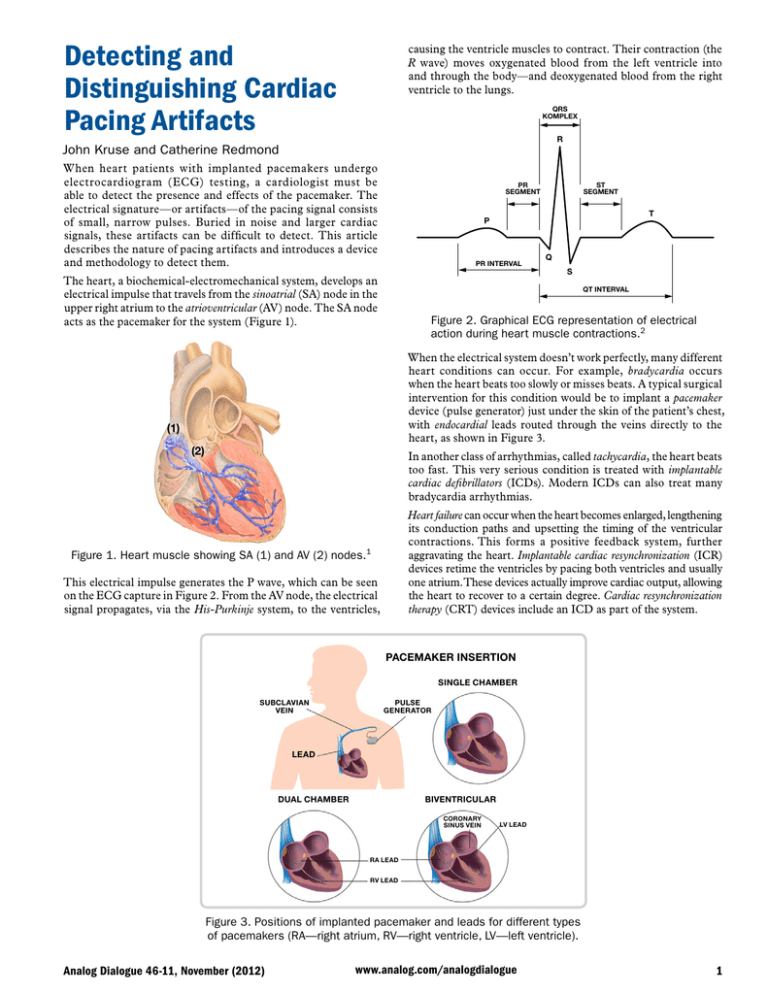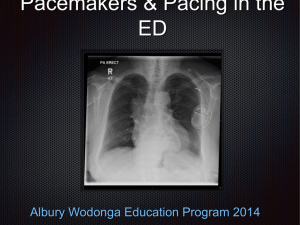Detecting and
advertisement

Detecting and Distinguishing Cardiac Pacing Artifacts causing the ventricle muscles to contract. Their contraction (the R wave) moves oxygenated blood from the left ventricle into and through the body—and deoxygenated blood from the right ventricle to the lungs. QRS KOMPLEX R John Kruse and Catherine Redmond When heart patients with implanted pacemakers undergo electrocardiogram (ECG) testing, a cardiologist must be able to detect the presence and effects of the pacemaker. The electrical signature—or artifacts—of the pacing signal consists of small, narrow pulses. Buried in noise and larger cardiac signals, these artifacts can be difficult to detect. This article describes the nature of pacing artifacts and introduces a device and methodology to detect them. PR SEGMENT ST SEGMENT T P PR INTERVAL The heart, a biochemical-electromechanical system, develops an electrical impulse that travels from the sinoatrial (SA) node in the upper right atrium to the atrioventricular (AV) node. The SA node acts as the pacemaker for the system (Figure 1). Q S QT INTERVAL Figure 2. Graphical ECG representation of electrical action during heart muscle contractions.2 When the electrical system doesn’t work perfectly, many different heart conditions can occur. For example, bradycardia occurs when the heart beats too slowly or misses beats. A typical surgical intervention for this condition would be to implant a pacemaker device (pulse generator) just under the skin of the patient’s chest, with endocardial leads routed through the veins directly to the heart, as shown in Figure 3. (1) (2) In another class of arrhythmias, called tachycardia, the heart beats too fast. This very serious condition is treated with implantable cardiac defibrillators (ICDs). Modern ICDs can also treat many bradycardia arrhythmias. Heart failure can occur when the heart becomes enlarged, lengthening its conduction paths and upsetting the timing of the ventricular contractions. This forms a positive feedback system, further aggravating the heart. Implantable cardiac resynchronization (ICR) devices retime the ventricles by pacing both ventricles and usually one atrium. These devices actually improve cardiac output, allowing the heart to recover to a certain degree. Cardiac resynchronization therapy (CRT) devices include an ICD as part of the system. Figure 1. Heart muscle showing SA (1) and AV (2) nodes.1 This electrical impulse generates the P wave, which can be seen on the ECG capture in Figure 2. From the AV node, the electrical signal propagates, via the His-Purkinje system, to the ventricles, PACEMAKER INSERTION SINGLE CHAMBER SUBCLAVIAN VEIN PULSE GENERATOR LEAD BIVENTRICULAR DUAL CHAMBER CORONARY SINUS VEIN LV LEAD RA LEAD RV LEAD Figure 3. Positions of implanted pacemaker and leads for different types of pacemakers (RA—right atrium, RV—right ventricle, LV—left ventricle). Analog Dialogue 46-11, November (2012) www.analog.com/analogdialogue 1 (a) (b) Figure 4. Fluoroscopy images showing pacemaker lead placement.3 (a). Single-chamber pacemaker. (b). Dual-chamber pacemaker. A CRT device is seen in the fluoroscopic image of Figure 4(a). This is the image that physicians use to place the leads. Such images are difficult for lay persons to interpret. You can see a light outline of the heart—a static view of a beating heart. It is lying on the right atrium with the apex of the heart pointing to the right and downward. In this typical lead placement, the black arrow points to the right atrium lead. The dashed black arrow points to the right ventricle lead. The partially seen lead, indicated by the red arrow, is the left ventricle lead (the red arrow points to the tip of the electrode). Figure 4(b) shows a fluoroscopy image of typical lead placement for a dual-chamber pacemaker. The right atrium lead is pointing up and is placed in the right atrium. The right ventricle lead is positioned at the apex of the right ventricle. Implantable pacemakers (Figure 5) are typically lightweight and compact. They contain the circuitry necessary to monitor the electrical activity of the heart through implanted leads and to stimulate the heart muscle when required to ensure a regular heartbeat. Pacemakers must be low-power devices, as they operate with a small battery that typically has a 10-year lifespan. As of 2010, the National Academy of Engineering states that over 400,000 pacemakers are implanted in patients every year.4 Pacing Artifacts A simple implanted pacer’s activity is generally not perceptible on a normal ECG trace because the very fast pulses—with widths of microseconds—get filtered out, but in any case, they are too narrow to appear on a trace with resolution in the milliseconds. However, its signals can be inferred by pacing artifacts, voltage pulses that accompany the measurement of the heart’s own electrical activity at the skin surface measured on ECG leads. It is important to be able to detect and identify pacing artifacts because they indicate the presence of the pacemaker—and help in evaluating its interaction with the heart. Their small amplitude, narrow width, and varying wave shape make pacing artifacts very difficult to detect, especially in the presence of electrical noise that can be many times their amplitude. Furthermore, pacing therapy has become extremely advanced, with dozens of pacing modes available—from single-chamber pacing to three-chamber pacing. To further complicate the detection of pacing artifacts, pacemakers produce lead-integrity pulses, minuteventilation (MV) pulses, telemetry signals, and other signals that can be incorrectly identified as pacing artifacts. The use of real-time pacemaker telemetry has made the display of pacing artifacts on an ECG strip less important than it used to be, but an individual skilled in pacing therapies can look at the strip to infer the type of pacing therapy being administered to the patient and determine whether the pacemaker is working properly. In addition, all pertinent medical standards, including the following, require the display of pacing artifacts. They do vary somewhat in their specific requirements regarding the height and width of the pacer signal that needs to be captured. • AAMI EC11:1991/(R)2001/(R)2007 • EC13:2002/(R)2007, IEC60601-1 ed. 3.0b, 2005 • IEC60601-2-25 ed. 1.0b • IEC60601-2-27 ed. 2.0, 2005 Figure 5. Example of a pacemaker device.5 2 • IEC60601-2-51 ed. 1.0, 2005 Analog Dialogue 46-11, November (2012) For example, IEC60601-2-27 states: Equipment shall be capable of displaying the ECG signal in the presence of pacemaker pulses with amplitudes of ±2 mV to ±700 mV and durations of 0.5 ms to 2.0 ms. An indication of the pacemaker pulse shall be visible on the display with an amplitude of no less than 0.2 mV referred to input (RTI); whereas, AAMI EC11 states: The device shall have the capability of displaying the ECG signal in the presence of pacemaker pulses with amplitudes between 2 mV and 250 mV, durations between 0.1 ms and 2.0 ms, a rise time of less than 100 µs, and a frequency of 100 pulses/minute. For pacemaker pulses having durations between 0.5 ms and 2.0 ms (and amplitude, rise time, and frequency parameters as specified above), an indication of the pacemaker pulse shall be visible on the recording; this indication shall be visible on the display with an amplitude of at least 0.2 mV RTI. These may be subtle differences, but they’re differences nonetheless, in terms of the heights and widths to be captured. How Pacemakers Pace All pacing leads have two electrodes, with the location of the electrodes determining the polarity of the signal. In unipolar pacing, the pacing leads consist of an electrode at the tip of a single pacing lead and the metal wall of the pacemaker housing (can) itself, so just one lead is inserted into the heart. The pacing artifacts caused by this mode of pacing can be several hundred millivolts at the skin surface with a width of a couple of milliseconds. Unipolar pacing is no longer commonly used. In bipolar pacing, the heart is paced from the electrode at the tip of the pacing lead. The return electrode is a ring electrode located very close to the tip electrode. Most pacing artifacts are now created by bipolar pacing. The artifacts produced by this type of lead are much smaller than those produced by unipolar pacing; pulses on the skin surface can be as small as a few hundred microvolts high and 25 μs wide, with average artifacts 1 mV high and 500 μs wide. The amplitude of the artifact can be much smaller when the detection vector does not line up directly with the pacing lead vector. Many pacemakers can be programmed for pulse widths as short as 25 μs, but these settings are typically used only in pacemaker threshold tests performed in an electrophysiology laboratory. Setting the lower limit to 100 μs eliminates the problem of falsely detecting minute ventilation (MV) and lead integrity (LV lead) pulses as valid pacing artifacts. These subthreshold pulses are usually programmed to be between 10 μs and 50 μs. Various types of available pacemakers pace different chambers: • Single-chamber pacing delivers pacing therapy to only one chamber of the heart; it can be either unipolar or bipolar. Single-chamber pacing is applied to the right atrium or the right ventricle. • Dual-chamber pacing delivers pacing therapy to both the right atrium and the right ventricle. • Biventricular pacing delivers pacing therapy to both the right ventricle and the left ventricle. In addition, the heart is usually paced in the right atrium. This mode of pacing can be very difficult to display properly for two main reasons: first, the two ventricle paces may occur at the same time, appearing as a single pulse at the skin surface. Second, the left ventricle lead placement is generally not on the Analog Dialogue 46-11, November (2012) same vector as the right ventricle lead and may actually be orthogonal to it. Usually, the right atrium is best displayed in Lead aVF, while the right ventricle is best displayed in Lead II. Most ECG systems do not employ three simultaneous lead-detection circuits or algorithms, making the left ventricle the toughest lead to pick up. Thus, it is sometimes best detected in one of the V leads. Pacing Artifact Waveforms Most pacing pulses have very fast rising edges. The rise time measured at the pacemaker output is generally about 100 ns. When measured at the skin surface, the rise time will be slightly slower because of the inductance and capacitance of the pacing lead. Most pacing artifacts at the skin surface are of the order of 10 μs or less. Complex devices with built-in protection, pacemakers can produce high-speed glitches that do not affect the heart but do affect pacemaker detection circuits. Figure 6 shows an example of an ideal pacing artifact. The positive pulse has a fast rising edge. After the pulse reaches its maximum amplitude, a capacitive droop follows, and then the trailing edge occurs. The artifact then changes polarity for the recharge portion of the pacing pulse. This recharge pulse is required so that the heart tissue is left with a net-zero charge. With a monophasic pulse, ions would build up around the electrodes, creating a dc charge that could lead to necropsy of the heart tissue. PACE PULSE PACELVLTH LEADING EDGE LEADING EDGE STOP PACEAMPTH PACEEDGETH PACE WIDTH RECHARGE PULSE Figure 6. Ideal pacing artifact. Introducing cardiac resynchronization devices adds another degree of complication in detecting and displaying pacing artifacts. These devices pace the patient in the right atrium and both ventricles. The pulses in the two ventricles can fall close together, overlap, or occur at exactly the same time; and the left ventricle can even be paced before the right ventricle. Currently, most devices pace both ventricles at the same time, but studies have shown that adjusting the timing will benefit most patients by yielding a higher cardiac output. Detecting and displaying both pulses separately is not always possible, and many times they will appear as a single pulse on the ECG electrodes. If both pulses occur at the same time, with the leads oriented in opposite directions, the pulses could actually cancel each other out on the skin surface. The probability of this occurring is very remote, but one can envision the appearance of two ventricle pacing artifacts on the skin surface with opposite polarities. If the two pulses were offset by a small time interval, the resulting pulse shape could be very complex. 3 Figure 7 shows scope traces of a cardiac resynchronization device pacing in a saline tank. This is a standard test environment for pacemaker validation; it is believed to be similar to the conductivity of the human body. The close proximity of the scope probes to the pacing leads causes the amplitudes to be much larger than what would be expected on the skin surface. In addition, the low impedance presented by the saline solution to the ECG electrodes results in much less noise than would normally be seen in a skin surface measurement. T BW M10.00ms CH3 –35.2mV Figure 7. Pace signal capture from resynchronization device in saline tank. The first pulse is the atrial, the second pulse is the right ventricle, and the third pulse is the left ventricle. The leads were placed in the saline tank with vectors optimized to see the pulses clearly. The negative-going pulse is the pace and the positive-going pulse is the recharge. The amplitude of the atrial pulse is slightly larger than the other two pulse amplitudes because the lead was in a slightly better vector than the ventricle leads, but in actuality, all three pacing outputs in the resynchronization device were programmed to have the same amplitude and width. With real patients, the amplitudes and widths are often different for each pacemaker lead. Detecting Pacing Artifacts With this understanding of the morphology and origin of the signals of interest, we can focus on the subject of detecting a pacing artifact. By their nature, it is impossible to detect all pacing artifacts and reject all possible noise sources in a cost-effective manner. Among the challenges are the number of chambers that pace detection must monitor, the interference signals encountered, and the variety of pacemakers from differing manufacturers. Solutions for detecting artifacts may range from hardware solutions to digital algorithms. These will all be discussed in more detail now. The pacing leads for cardiac resynchronization devices will not all have the same vector. The right atrium lead usually aligns with Lead II, but it can sometimes point straight out of the chest, so a Vx vector may be needed to see it. The right ventricle lead is usually placed at the apex of the right ventricle, so it usually aligns well with Lead II. The left ventricle pacing lead, threaded through the coronary sinus, is actually on the outside of the left ventricle. This lead usually aligns with Lead II but may have a 4 One of the major noise sources is the H-field telemetry scheme used by most implantable heart devices. Other sources of noise include transthoracic impedance measurements for respiration, electric cautery, and conducted noises from other medical devices connected to the patient. To further complicate the problem of acquiring pacing artifacts, each pacemaker manufacturer uses a different telemetry scheme. In some cases, a single manufacturer may use many different telemetry systems for different implantable device models. Many implantable devices can actually communicate using both H-field telemetry and either MICS- or ISM-band telemetry. The variability of H-field telemetry from one model to the next makes filter design very difficult. ECG devices have to be Class CF, but other medical devices may be Class B or BF, and their higher leakage currents may interfere with the performance of ECG acquisition devices. 3 CH3 20.0mV V-axis orientation. The pacing leads of implantable defibrillators and resynchronization devices are sometimes placed in areas of the heart that have not had an infarction. Placing them around infarcts is the main reason that this system uses three vectors and requires a high-performance pacing-artifact detection function. ADAS1000 ECG Analog Front End Includes Pacing Artifact Detection Algorithm The ADAS1000 (Figure 8) is a 5-channel electrocardiography (ECG) analog front end (AFE) designed to help address some of the challenges facing designers of next-generation low-power, low-noise, high-performance, tethered- and portable ECG systems. The ADAS1000, designed for both monitor- and diagnosticquality ECG measurements, comprises five electrode inputs and a dedicated right-leg-drive (RLD) output reference electrode. In addition to supporting the essential ECG signal-monitoring elements, the ADAS1000 is equipped with functions such as respiration measurement (thoracic impedance measurement), lead/ electrode connection status, internal calibration, and capabilities for pace artifact detection—as discussed above. One ADAS1000 supports five electrode inputs, facilitating a traditional 6-lead ECG measurement. By cascading a second ADAS1000-2 (companion) device, the system can be scaled up to a true 12-lead measurement; and by cascading multiple devices (three and above), the system can be scaled to measurements with 15 leads and beyond. See Table 1 for details on the different variants of the ADAS1000. The respiration feature of the ADAS1000 provides the ability to measure thoracic impedance variations of the patient, indicating the extent, or absence, of breathing. At the heart of the respiration function is an integrated DAC (digital-to-analog converter) respiration drive at a programmable frequency (46 kHz to 64 kHz), and a dedicated analog-to-digital measuring circuit that simplifies this difficult measurement. The signal is demodulated and provided as magnitude and phase information, from which the corresponding respiration can be determined, given the specific cable parameters. The circuit is capable of detecting resolutions as small as 200 mΩ, using the internal capacitor—with even more-precise resolution, using an external capacitor—and has a flexible switching scheme, allowing measurement on one of three leads (I, II, III). Analog Dialogue 46-11, November (2012) REFIN REFOUT CAL_DAC_IO RLD_SJ CM_OUT/WCT RLD_OUT CM_IN DRIVEN LEAD AMP VREF CALIBRATION DAC AVDD SHIELD SHIELD DRIVE AMP ADCVDD, DVDD 1.8V REGULATORS ADCVDD DVDD VCM_REF (1.3V) RESPIRATION DAC COMMONMODE AMP AC LEAD-OFF DAC AC LEAD-OFF DETECTION 10k𝛀 MUXES IOVDD PACE DETECTION BUFFER SCLK 5× ECG PATH ELECTRODES ×5 CS SDI AMP EXT RESP_LA AMP EXT RESP LL EXT RESP_RA ADAS1000 FILTERS, CONTROL, AND INTERFACE LOGIC ADC SDO DRDY GPIO0/MCS GPIO1/MSCLK GPIO2/MSDO GPIO3 ADC CLOCK GEN/OSC/ EXTERNAL CLK SOURCE RESPIRATION PATH XTAL1 CLK_IO XTAL2 Figure 8. ADAS1000 block diagram. Table 1. Overview of Available Models of the ADAS1000 Number of Electrodes Extra Features Input Noise, 0.05 Hz to 150 Hz (𝛍V p-p) CM I/P Range (V) Supply Voltage Package Option ADAS1000 5 ECG electrodes + RLD Respiration, pace, and pace I/F 10 ±1 3.3 to 5.5 56-lead LFCSP 64-lead LQFP ADAS1000-1 5 ECG electrodes + RLD 10 ±1 3.3 to 5.5 56-lead LFCSP ADAS1000-2 5 ECG electrodes (companion for gang mode) 10 ±1 3.3 to 5.5 56-lead LFCSP 64-lead LQFP ADAS1000-3 3 ECG electrodes + RLD 10 ±1 3.3 to 5.5 56-lead LFCSP 64-lead LQFP ADAS1000-4 3 ECG electrodes + RLD 10 ±1 3.3 to 5.5 56-lead LFCSP 64-lead LQFP Part Number Respiration, pace, and pace I/F Pace Detection Algorithm The device’s front end includes a digital pacemaker artifactdetection algorithm that detects pacing artifacts with widths that range from 100 μs to 2 ms, and amplitudes that range from 400 μV to 1000 mV—to align with the AAMI and IEC standards listed above. Based on testing and physician input, these limits are much more generous than the medical standards call for. of 400 μV to 1000 mV, it returns a flag that indicates pace was detected on one or more of the leads, and also the measured height and width of the detected signal. For users who wish to run their own digital pace algorithm, the ADAS1000 provides a high-speed pace interface that provides the ECG data at a fast data rate (128 kHz), while the filtered and decimated ECG data remains unchanged on the standard interface. The pace-detection algorithm runs three instances of a digital algorithm on three of four possible leads (I, II, III, or aVF). It runs on the high-frequency ECG data, in parallel with the internal decimation and filtering. Designed to detect and measure pacing artifacts with widths ranging from 100 μs to 2 ms, and amplitudes The ADAS1000 ECG IC has a minute-ventilation filter built into its algorithm. Minute-ventilation pulses, which are conducted from the ring of a bipolar lead to the can of the pacemaker, detect respiration rates to control the pacing rate. They’re always less than 100 μs wide, varying from about 15 μs to 100 μs. Analog Dialogue 46-11, November (2012) 5 Many implantable devices are capable of being programmed for pacing pulses as narrow as 25 µs, but physicians almost never program implantable devices with pulses that narrow because there would not be enough of a safety margin of energy above the pacing threshold. This pacing artifact system was developed by a team of engineers and pacing experts who worked in conjunction with the pacing industry. The result of this collaboration is a simultaneous threevector pacing-artifact system that can detect pacing artifacts despite electrical noise that is significantly larger that the artifacts. Each of the three instances of the pace algorithm can be programmed to detect pace signals on different leads (I, II, II, or aVF). Programmable threshold levels allow it to be tailored to detect the range of pulse widths and heights presented, with internal digital filters designed to reject heartbeat, noise, and minute-ventilation pulses. When a pace has been validated in an individual instance of the pace signal, the device outputs a flag so that the user can mark or identify the pace signal in the ECG capture strip. A simplified flowchart of the pacemaker algorithm is shown in Figure 9. Conclusion Artifacts from implanted pacemakers can vary from 2 mV to 700 mV—with durations between 0.1 ms and 2 ms and rise times between 15 µs and 100 µs. Often swamped by telemetry noise or cardiac signals, they can be difficult to detect. The ADAS1000 analog front end for ECG systems includes all of the circuitry required to detect the electrical signals produced by a heart and its associated pacemaker—and an embedded algorithm that can help distinguish pacing artifacts and display them on the ECG strip chart. 1 ENABLE PACE DETECTION SELECT LEADS Jaffe, C. Carl, MD, cardiologist and Patrick J. Lynch, medical illustrator. http://en.wikipedia.org/wiki/File:Reizleitungssystem_1.png. 2 http://en.wikipedia.org/wiki/File:SinusRhythmLabels.svg. START PACE DETECTION ALGORITHM LOOK FOR TRAILING EDGE As mentioned above, the ADAS1000 also includes respiration measurement and ac leads off. These features both inject ac signals at different frequencies onto the patient electrodes, but they don’t interfere with the acquisition of pacing artifacts. Electric cautery signals can be filtered ahead of the ADAS1000 inputs for ECG, but performance of the pacing artifact detection algorithm may be degraded by the filtering, so care must be taken with its design. References START START PULSE WIDTH TIMER believes that the sampling frequency employed by the ADAS1000 does not line up with any of the major telemetry systems of these three pacing companies. 3 START NOISE FILTERS (if enabled) (b) http://en.wikipedia.org/wiki/File:Fluoroscopy_pacemaker_ leads_right_atrium_ventricle.png. 4 http://www.nae.edu/page20019090/WhatisaPacemaker.aspx. 5 TRAILING EDGE DETECTED? NO NO YES 2ms > PULSE WIDTH > 100𝛍s NO YES FLAG PACE DETECTED UPDATE REGISTERS WITH WIDTH AND HEIGHT Figure 9. Flowchart of the pace algorithm. The choice of sample rate for the pacing artifact algorithm is significant because it cannot be exactly the same frequency as those used by Medtronic, St. Jude, and Boston Scientific for the H-field telemetry carrier. All three corporations use different frequencies, and each has many different telemetry systems. Analog Devices 6 http://en.wikipedia.org/wiki/File:St_Jude_Medical_pacemaker_ with_ruler.jpg. Authors YES NOISE FILTER PASSED? (a) http://en.wikipedia.org/wiki/File:Cardiac_resynchronisation_ therapy.png. John Kruse [john.kruse@analog.com] is a field applications engineer at Analog Devices, based in Minneapolis, Minnesota. He joined ADI in 2005 where he has specialized in medical applications. He has authored many articles and patents, and several of the patents covered pacing-artifact acquisition. He has worked in the medical industry for over 20 years. John graduated with a BSEE from the University of Minnesota in 1980 and an MSEE from the University of St. Thomas in 1997, where he currently is an adjunct professor, instructing several engineering graduate classes. Catherine Redmond [catherine.redmond@analog.com] is an applications engineer at Analog Devices in Limerick, Ireland. Since joining ADI in 2005, she has accumulated a wealth of experience in the industrial market arena through time spent supporting precision DACs as applied in automatic test equipment, and she now has a focus on precision ADC products, including applications responsibility for the ADAS1000 ECG front end. She graduated from Cork Institute of Technology with a bachelor’s degree in electronic engineering and has since worked in an applications role within Analog Devices. Analog Dialogue 46-11, November (2012)






